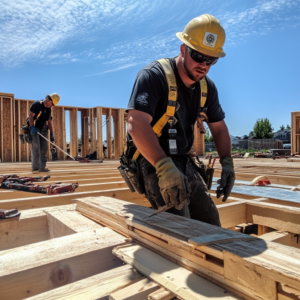In the U.S., as we move from neighborhood to neighborhood, city to city and even state to state, we are most likely utilizing the work of our nation’s Department of Transportations (DOT). From highways to bridges and railways to waterways, those employed by the DOT have the massive responsibility of getting those in the U.S. where they need to be and safely.
In our 5th Annual Axe Photo Contest, we had the pleasure of seeing behind a Virginia Department of Transportation (VDOT) project submitted by Ricky Lewis, EIT 3.
Working in inspections, we recently spoke with Ricky about his more than 20 years working in the industry. Read our latest Behind the Build interview, below!
What first got you into construction?
I started working as a carpenter at age 15. I’ve been a part of the industry now for 27. Currently, I do bridge inspections for VDOT during new construction projects.
Could you share some of your first experiences working in the industry?
My first inspection job was the Johns Hopkins Cancer research center in Baltimore, MD. It was a high rise building, and the size of it was very intimidating to me at first.
I remember thinking I would never be able to make it in this industry.
It has been 20 plus years since that job. It has never lost its interest to me and I love my job!
What do you love most about working in the construction industry?
I have always liked how the inspection industry has challenged me to learn every day on the job. Even to this day, I still come across new things–it has never gotten old.
Tell us more about the project you photographed for the Axe Contest. Why are you proud of working on this project with VDOT?
For the Axe Contest, I shared a photo I captured from the Rte.100 Bridge Improvements in Virginia. I have always loved bridge jobs like this one just because of the size. Large bridge building jobs have a lot of structural elements to check and usually take several years to build.
I like knowing that when the job is done that many generations to come will utilize the structure I have helped build.
For you, what is the most challenging part of working in the construction industry?
For me, the most challenging part is overcoming the varying weather conditions on the job. You never know what to expect some days and managing logistics can be challenging.
How has technology changed the way you work in construction?
Today, design and plan modifications can be done much faster with the help of technology. As a result, questions and solutions are relayed much faster, making jobs run smoother.
How does PlanGrid benefit you on the job?
I first started using PlanGrid in Baltimore in 2014 to track issues on the Campbell Blvd bridge project. For me, plan markup and sharing are the features I use the most. It addresses issues in real time so all involved can see it. Overall, PlanGrid allows for quicker on-site documentation and troubleshooting with the Engineering departments when issues are encountered.
What would you like to tell the next generation of builders?
While you are in school, start early and work as an intern for an engineering firm. The connections you make in the industry will help you find success in the future.




Responses